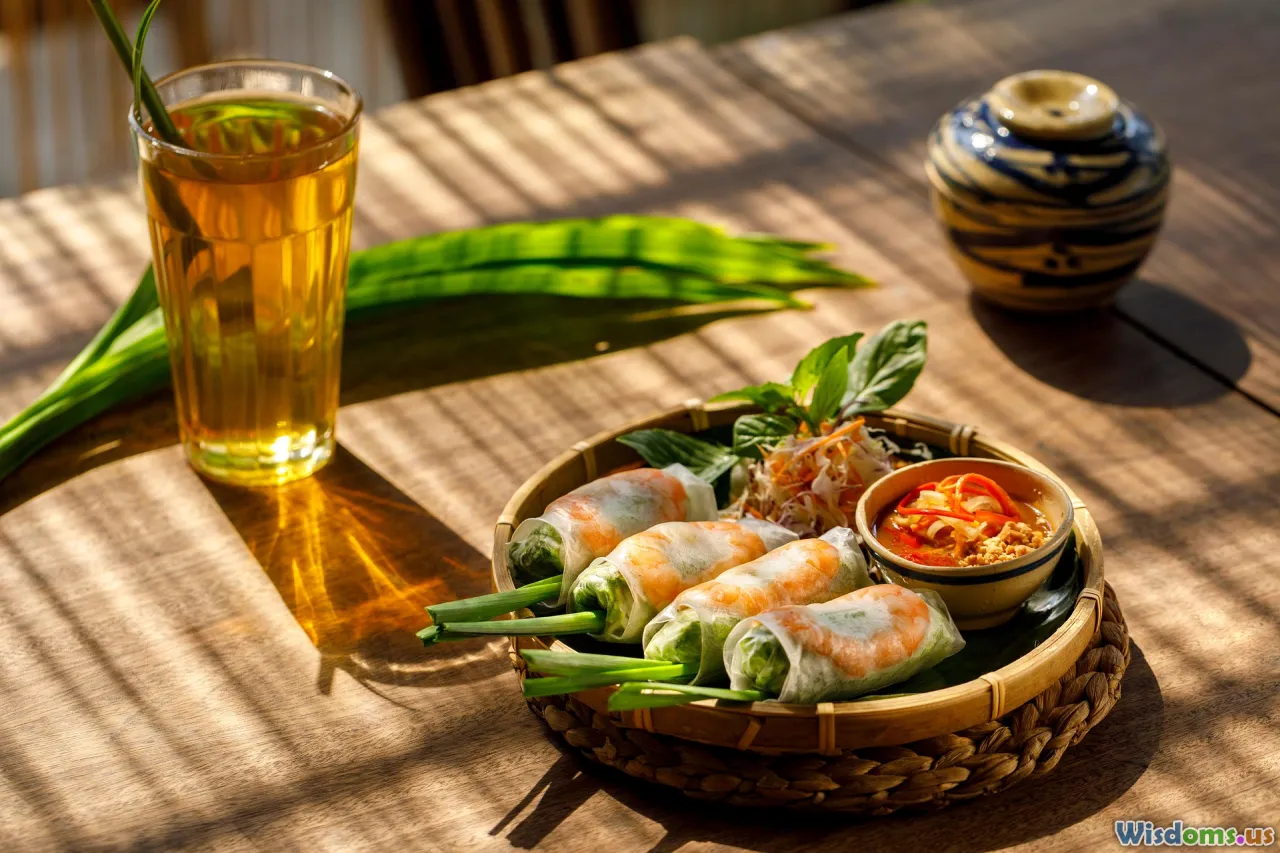
Ten Must Try Dishes in Vietnams Ancient Towns
10 min read Discover ten iconic dishes from Vietnam’s ancient towns, blending history and flavor in every bite. (0 Reviews)
Ten Must-Try Dishes in Vietnam’s Ancient Towns
Vietnam’s ancient towns are living museums not only of architecture and culture, but also of culinary traditions shaped over centuries. These towns—like Hoi An, Hue, and Hanoi’s Old Quarter—are culinary treasure troves where local dishes remain rooted in authentic recipes handed down through generations. For food lovers and cultural explorers alike, tasting the local cuisine is a vital way to truly understand the soul of Vietnam’s ancient heritage.
Let’s embark on a flavorful journey through ten remarkable dishes that define the heritage, history, and vibrant flavors of Vietnam’s iconic ancient towns.
1. Cao Lầu – Hoi An’s Legendary Noodle Dish
Cao Lầu is arguably Hoi An’s most famous culinary treasure and represents a unique blend of history and local ingredients. This dish is a rice noodle specialty distinguished by its chewy texture — attributed in part to water drawn from a specific ancient Cham well in Hoi An, as well as leftover lye water.
Ingredients and Preparation:
- Thick, chewy rice noodles
- Slices of expertly grilled pork
- Fresh local greens and herbs, including mint and perilla
- Crispy fried croutons made from rice crackers
- Light broth or minimal sauce
The balance of textures—from the firm noodles to the crunchy crackers—alongside mild, smoky pork creates an unforgettable complexity. Some locals refer to it as the “soul of Hoi An.”
Historical Insight: Hong Duc, a 15th-century Vietnamese emperor, influenced the cultural melting pot that created Cao Lầu. The dish reflects a mix of Japanese, Chinese, and Vietnamese influences, especially with its noodles resembling Japanese soba.
2. Bún Bò Huế – Royal Flavors from Hue
Hue, the old imperial capital, is famed for its regal culinary traditions where food was an art form enjoyed by the Nguyen dynasty kings. Bún bò Huế is a spicy beef noodle soup famed for its depth of flavors and crustacean-savory aroma.
Key Components:
- Thick rice noodles
- Beef shank, pork knuckles, and sometimes congealed pig’s blood cubes
- Spicy broth spiked with lemongrass, shrimp paste, and chili oil
- Garnished with banana blossoms, lime, onions, and cilantro
The trademark of Bún bò Huế lies in its balanced spiciness and robust lemongrass scent. Unlike the milder Pho, Bún bò Huế was designed to satisfy the palates of Hue’s aristocracy, who sought complexity and grandeur in cuisine.
Local Recommendation: Quán Bà Đỏ, a family-run stall in Hue for decades, is heralded for maintaining authentic tastes that echo royal recipes.
3. Bánh Xèo – The Crispy Vietnamese Pancake of Quang Nam Province
Although enjoyed throughout Vietnam, Bánh Xèo’s origins are strongly tied to Quang Nam province, near Hoi An. This sizzling, golden pancake filled with shrimp, pork, and bean sprouts delivers a satisfying crunch and savory bite.
Culinary Highlights:
- Rice flour batter enhanced with turmeric for color
- Popular fillings include local river shrimp and pork belly
- Wrapped in mustard leaves and herbs, dipped into fermented fish sauce
Bánh Xèo's expert crispiness is a delicate art—too thick or thin, and the texture fails. Vendors often cook these pancakes over charcoal stoves to achieve that classic crackling finish.
4. Nem Lui – Hue’s Grilled Lemongrass Pork Skewers
Nem Lụi, originating in Hue, is a street food favorite featuring ground pork spiced with lemongrass, then grilled over charcoal, infused with unmistakable smokiness.
Eating Experience:
- Wrapped in fresh rice paper with herbs like mint and perilla
- Served alongside thick rice vermicelli and fermented shrimp paste dipping sauce
The harmony between lemongrass fragrance, charred juiciness, and herbal freshness embodies Hue’s culinary finesse—simple yet elegant.
5. Bánh Cuốn Thanh Trì – Delicate Rice Rolls of Hanoi
This traditional Vietnamese steamed rice roll is especially celebrated in Hanoi’s Thanh Trì district. Unlike other versions filled with pork and mushroom, Thanh Trì’s version has a translucent rice wrapper with a minced pork and wood ear mushroom filling, moist and tender.
Noteworthy Flavor Points:
- Rice sheets delicately thin, almost see-through
- Served with fish sauce infused with lime juice, sliced chili, and finely chopped garlic
- Garnished with crispy fried shallots and fresh herbs
Locals often savor Bánh Cuốn as a breakfast staple that evokes nostalgia.
6. Chè Hội An – Sweet Soups Offering a Taste of Tradition
Chè, meaning “sweet soup,” is ubiquitous across Vietnam, but Hoi An’s versions stand out for their authenticity made from ancient recipes preserved by local families.
Popular varieties include:
- Chè đậu xanh (mung bean sweet soup)
- Chè bắp (corn pudding)
- Chè hạt sen (lotus seed sweet soup)
These desserts provide a refreshing contrast after savoring rich, savory dishes and reflect Vietnam’s agricultural bounty with natural sweetness.
7. Mì Quảng – Quang Nam’s Flavorful Turmeric Noodle Bowl
Another Hoi An highlight is Mì Quảng, an aromatic noodle dish made with turmeric-stained yellow noodles, typically served with a sparse broth, a handful of herbs, crunchy peanuts, toasted sesame rice crackers, and various proteins such as shrimp, pork, or chicken.
Cultural Significance: Considered a communal sharing dish traditionally served during festivals in Quang Nam province, Mì Quảng embodies the heart of local hospitality.
8. Bánh Đập – The Cracking Pancakes of Hue
A specialty from Hue, Bánh Đập includes two layered pancakes—the soft steamed translucent rice pancake paired with a crispy sesame rice cracker on top. The name “bánh đập” comes from the cracking sound made when eating the pancakes together.
Taste Elements:
- Fresh herbs and chopped roasted peanuts
- Robust fermented shrimp sauce adds umami depth
This dish highlights the region’s intricate balance between texture and flavor.
9. Xôi Vò – Sticky Rice with Mung Bean from Hue
Xôi Vò is a traditional Hue specialty that may look simple but needs skillful preparation. Glutinous rice is steamed and mixed finely with ground mung beans, delivering a dry, powdery texture unlike typical sticky rice dishes.
Why It’s Special: The rigorous pounding and washing create a light, fragrant texture. Sometimes served with fried shallots or salt, this dish is a beloved snack showcasing Hue’s culinary uniqueness.
10. Bánh Mì Phượng – Hoi An’s Famous Sandwich
While bánh mì is a national favorite, Hoi An’s Bánh Mì Phượng elevates the sandwich to iconic status due to its fresh ingredients and balance of flavors.
Inclusions:
- Crispy French baguette
- A variety of meats: grilled pork, chicken, and pâté
- Pickled vegetables, fresh cilantro, and chili
Anthony Bourdain famously praised this place as one of the best bánh mì in the world, highlighting Hoi An’s status as a culinary pilgrimage spot.
Conclusion
Exploring Vietnam’s ancient towns through their cuisine offers deep insight into the country’s cultural history and regional identity. Each dish on this list marries time-honored techniques with local ingredients, preserving authenticity in a rapidly modernizing world. Whether you’re chasing the smoky lemongrass of Nem Lụi or the royal complexity of Bún Bò Huế, these ten dishes not only satisfy the palate but also tell the stories of Vietnam’s rich past.
Next time you plan a Vietnamese adventure, consider delighting your senses in these ancient towns—your taste buds will thank you for this rare plunge into authentic, centuries-old Vietnamese gastronomy.
Bon appétit or, as the locals say, Enjoy your meal — Chúc ngon miệng!
Rate the Post
User Reviews
Popular Posts

















